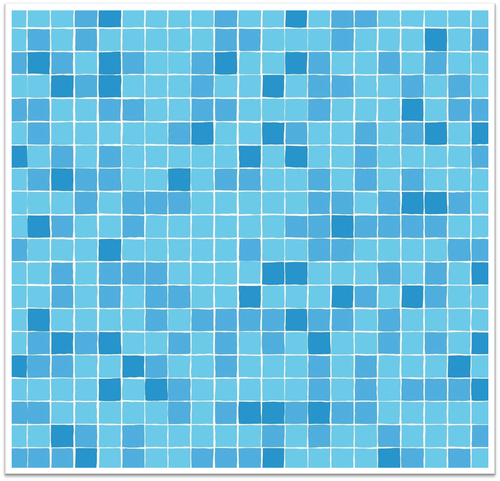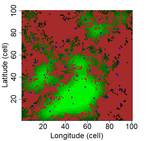
ZURELL Damaris
- Geography Department, Humboldt-Universität zu Berlin, Berlin, Germany
- Biodiversity, Biogeography, Climate change, Demography, Dispersal & Migration, Habitat selection, Macroecology, Spatial ecology, Metacommunities & Metapopulations, Species distributions, Theoretical ecology
- recommender
Recommendations: 2
Reviews: 0
Recommendations: 2

Using informative priors to account for identifiability issues in occupancy models with identification errors
Accounting for false positives and negatives in monitoring data from sensor networks and eDNA
Recommended by Damaris Zurell based on reviews by Saoirse Kelleher, Jonathan Rose and 2 anonymous reviewersBiodiversity monitoring increasingly relies on modern technologies such as sensor networks and environmental DNA. These high-throughput methods allow biodiversity assessments with unprecedented detail and are especially useful to detect rare and secretive species that are otherwise difficult to observe with traditional survey-based methods. False negatives through imperfect detection are a typical problem in survey data and depend on intrinsic characteristics of the species, site characteristics of the survey site as well as survey characteristics (Guillera 2017). While imperfect detection might be reduced in modern sensor data and eDNA data, also these types of data are by no means error-free and may bare other challenges. In particular, the bioinformatics and image classification approaches used for species identification from these data can induce a higher rate of false positives than would be expected in expert-based survey data (Hartig et al. 2024).
Occupancy models (or occupancy-detection models) have been widely used to map species distributions by fitting a hierarchical model that estimates the paramaters of both the species-environment relationship and an observation submodel. They account for false negatives by inferring detectability from the detection history of a survey location, for example from replicate visits or multiple observers (Guillera 2017). These basic occupancy-detection models assume no false positive errors in the data. Other authors have proposed extensions for false positives that typically rely on unambiguous (known truth) information for some sites or observations (Chambert et al. 2015).
In their preprint, Monchy et al. (2024) propose an extension of classic occupancy models that considers a two-step observation process modelling the detection probability at occupied sites and the associated identification probability, separated into the true positive identification rate and the true negative identification rate. Using a simulation approach, the authors compare the effectiveness of a frequentist (maximum likelihood-based) and Bayesian approach for parameter estimation and identifiability, and additionally test the effectiveness of different priors (from non-informative to highly informative). Results of the maximum-likelihood approach indicated biased parameter estimates and identifiability problems. In the Bayesian approach, inclusion of prior information greatly reduces biases in parameter estimates, especially in detection and positive identification rate.
Importantly, informative priors for the identification process are a by-product of the classifiers that are developed for processing the eDNA data or sensor data. For example, species identification from acoustic sensors is based on image classifiers trained on labelled bird song spectrograms (Kahl et al. 2021) and as part of the evaluation of the classifier, the true positive rate (sensitivity) is routinely being estimated and could thus be readily used in occupancy models accounting for false positives. Thus, the approach proposed by Monchy et al. (2024) is not only highly relevant for biodiversity assessments based on novel sensor and eDNA data but also provides very practical solutions that do not require additional unambiguous data but recycle data that are already available in the processing pipeline. Applying their framework to real-world data will help reducing biases in biodiversity assessments and through improved understanding of the detection process it could also help optimising the design of sensor networks.
References
Thierry Chambert, David A. W. Miller, James D. Nichols (2015), Modeling false positive detections in species occurrence data under different study designs. Ecology, 96: 332-339. https://doi.org/10.1890/14-1507.1
Gurutzeta Guillera-Arroita (2017) Modelling of species distributions, range dynamics and communities under imperfect detection: advances, challenges and opportunities. Ecography, 40: 281-295. https://doi.org/10.1111/ecog.02445
Florian Hartig, Nerea Abrego, Alex Bush, Jonathan M. Chase, Gurutzeta Guillera-Arroita, Mathew A. Leibold, Otso Ovaskainen, Loïc Pellissier, Maximilian Pichler, Giovanni Poggiato, Laura Pollock, Sara Si-Moussi, Wilfried Thuiller, Duarte S. Viana, David I. Warton, Damaris Zurell D, Douglas W. Yu (2024) Novel community data in ecology - properties and prospects. Trends in Ecology & Evolution, 39: 280-293. https://doi.org/10.1016/j.tree.2023.09.017
Stefan Kahl, Connor M. Wood, Maximilian Eibl, Holger Klinck (2021) BirdNET: A deep learning solution for avian diversity monitoring. Ecological Informatics, 61: 101236. https://doi.org/10.1016/j.ecoinf.2021.101236
Célian Monchy, Marie-Pierre Etienne, Olivier Gimenez (2024) Using informative priors to account for identifiability issues in occupancy models with identification errors. bioRxiv, ver.3 peer-reviewed and recommended by PCI Ecology https://doi.org/10.1101/2024.05.07.592917

Three points of consideration before testing the effect of patch connectivity on local species richness: patch delineation, scaling and variability of metrics
Good practice guidelines for testing species-isolation relationships in patch-matrix systems
Recommended by Damaris Zurell based on reviews by 3 anonymous reviewersConservation biology is strongly rooted in the theory of island biogeography (TIB). In island systems where the ocean constitutes the inhospitable matrix, TIB predicts that species richness increases with island size as extinction rates decrease with island area (the species-area relationship, SAR), and species richness increases with connectivity as colonisation rates decrease with island isolation (the species-isolation relationship, SIR)[1]. In conservation biology, patches of habitat (habitat islands) are often regarded as analogous to islands within an unsuitable matrix [2], and SAR and SIR concepts have received much attention as habitat loss and habitat fragmentation are increasingly threatening biodiversity [3,4].
The existence of SAR in patch-matrix systems has been confirmed in several studies, while the relative importance of SIR remains debated [2,5] and empirical evidence is mixed. For example, Thiele et al. [6] showed that connectivity effects are trait specific and more important to explain species richness of short-distant dispersers and of specialist species for which the matrix is less permeable. Some authors have also cautioned that the relative support for or against the existence of SIR may depend on methodological decisions related to connectivity metrics, patch classification, scaling decisions and sample size [7].
In this preprint, Laroche and colleagues [8] argue that methodological limits should be fully understood before questioning the validity of SIR in patch-matrix systems. In consequence, they used a virtual ecologist approach [9] to qualify different methodological aspects and derive good practice guidelines related to patch delineation, patch connectivity indices, and scaling of indices with species dispersal distance.
Laroche et al. [8] simulated spatially-explicit neutral meta-communities with up to 100 species in artificial fractal (patch-matrix) landscapes. Each habitat cell could hold up to 100 individuals. In each time step, some individuals died and were replaced by an individual from the regional species pool depending on relative local and regional abundance as well as dispersal distance to the nearest source habitat cell. Different scenarios were run with varying degrees of spatial autocorrelation in the fractal landscape (determining the clumpiness of habitat cells), the proportion of suitable habitat, and the species dispersal distances (with all species showing the same dispersal distance). Laroche and colleagues then sampled species richness in the simulated meta-communities, computed different local connectivity indices for the simulated landscapes (Buffer index with different radii, dIICflux index and dF index, and, finally, related species richness to connectivity.
The complex simulations allowed Laroche and colleagues [8] to test how methodological choices and landscape features may affect SIR. Overall, they found that patch delineation is crucial and should be fine enough to exclude potential within-patch dispersal limitations, and the scaling of the connectivity indices (in simplified words, the window of analyses) should be tailored to the dispersal distance of the species group. Of course, tuning the scaling parameters will be more complicated when dispersal distances vary across species but overall these results corroborate empirical findings that SIR effects are trait specific [6]. Additionally, the results by Laroche and colleagues [8] indicated that indices based on Euclidian rather than topological distance are more performant and that evidence of SIR is more likely if Buffer indices are highly variable between sampled patches.
Although the study is very technical due to the complex simulation approach and the different methods tested, I hope it will not only help guiding methodological choices but also inspire ecologists to further test or even revisit SIR (and SAR) hypotheses for different systems. Also, Laroche and colleagues propose many interesting avenues that could still be explored in this context, for example determining the optimal grid resolution for the patch delineation in empirical studies.
References
[1] MacArthur, R.H. and Wilson, E.O. (1967) The theory of island biogeography. Princeton University Press, Princeton.
[2] Fahrig, L. (2013) Rethinking patch size and isolation effects: the habitat amount hypothesis. Journal of Biogeography, 40(9), 1649-1663. doi: 10.1111/jbi.12130
[3] Hanski, I., Zurita, G.A., Bellocq, M.I. and Rybicki J (2013) Species–fragmented area relationship. Proceedings of the National Academy of Sciences U.S.A., 110(31), 12715-12720. doi: 10.1073/pnas.1311491110
[4] Giladi, I., May, F., Ristow, M., Jeltsch, F. and Ziv, Y. (2014) Scale‐dependent species–area and species–isolation relationships: a review and a test study from a fragmented semi‐arid agro‐ecosystem. Journal of Biogeography, 41(6), 1055-1069. doi: 10.1111/jbi.12299
[5] Hodgson, J.A., Moilanen, A., Wintle, B.A. and Thomas, C.D. (2011) Habitat area, quality and connectivity: striking the balance for efficient conservation. Journal of Applied Ecology, 48(1), 148-152. doi: 10.1111/j.1365-2664.2010.01919.x
[6] Thiele, J., Kellner, S., Buchholz, S., and Schirmel, J. (2018) Connectivity or area: what drives plant species richness in habitat corridors? Landscape Ecology, 33, 173-181. doi: 10.1007/s10980-017-0606-8
[7] Vieira, M.V., Almeida-Gomes, M., Delciellos, A.C., Cerqueira, R. and Crouzeilles, R. (2018) Fair tests of the habitat amount hypothesis require appropriate metrics of patch isolation: An example with small mammals in the Brazilian Atlantic Forest. Biological Conservation, 226, 264-270. doi: 10.1016/j.biocon.2018.08.008
[8] Laroche, F., Balbi, M., Grébert, T., Jabot, F. and Archaux, F. (2020) Three points of consideration before testing the effect of patch connectivity on local species richness: patch delineation, scaling and variability of metrics. bioRxiv, 640995, ver. 5 peer-reviewed and recommended by PCI Ecology. doi: 10.1101/640995
[9] Zurell, D., Berger, U., Cabral, J.S., Jeltsch, F., Meynard, C.N., Münkemüller, T., Nehrbass, N., Pagel, J., Reineking, B., Schröder, B. and Grimm, V. (2010) The virtual ecologist approach: simulating data and observers. Oikos, 119(4), 622-635. doi: 10.1111/j.1600-0706.2009.18284.x